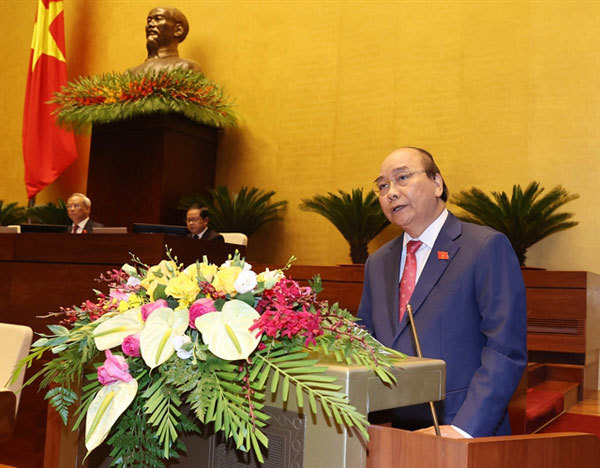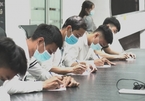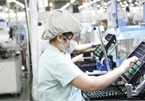 |
| Prime Minister Nguyen Xuan Phuc delivered the socio-economic reports in front of the National Assembly on Tuesday in Hanoi. — VNA/VNS Photo Trong Duc |
Prime Minister Nguyen Xuan Phuc made the statement on Tuesday as he delivered Government’s socio-economic reports of 2020 and of 2016-20, as well as the plan for 2021 and tasks towards 2025, in front of the National Assembly as the Vietnamese legislature opened its 10th sitting.
PM Phuc said in 2020 and 2016-20, the regional and global situations proved more “complicated” than forecast, with increasingly harsh competition between the world’s powers, intense trade conflicts and risks in international financial and monetary markets, the far-reaching impacts brought by the fourth industrial revolution, and the outbreak of COVID-19 in early 2020 that has crippled the world’s economy.
Despite previous development momentum, Vietnam’s economy was not exempt – businesses coming to a halt, many social and cultural activities were severely impacted while millions of workers face job losses or dwindling income, the Government leader noted, adding that extreme natural phenomena like droughts, flooding, landslides, or salt intrusion have also gravely affected people’s lives and livelihood.
The Government in 2020 has given instructions to all agencies and administration levels on the determination to pursue the “double goals” of containing the coronavirus spread – with the spirit of “fighting the pandemic like fighting an enemy” – while giving attention to socio-economic recovery and development efforts to ensure people’s livelihoods, PM Phuc said, remarking that disease control remains the “highest priority” to ensure public health.
The Government has built “appropriate, flexible, and creative” responses and implemented lockdowns at appropriate levels, upheld transparent communications and updated information to the public, and mobilised the entire political system and the public – especially frontline forces such as the health, military, public security, and diplomatic units – in the fight against the disease at a level higher and earlier than recommendations from the World Health Organization.
Relief measures such as extending loans, debt restructuring, lowering interest rates and providing support for those suffering from job and income losses, as well as pushing for faster and effective disbursement of public investment, have been implemented to address the hardship faced by people and businesses.
So far, Vietnam had shown competent handling of the pandemic, PM Phuc said, adding that the initial successes demonstrated the superiority of Vietnam’s political system, the unity, solidarity and patriotism of the Vietnamese people, furthering their confidence in the Party and State.
Vietnam’s GDP in 2020 is estimated to grow by 2-3 per cent against last year, one of the rare countries in the region and the world to still post positive growth, but this falls short of the original target of 6.8 per cent.
Citing an International Monetary Fund report, PM Phuc said Vietnam’s economy in 2020 could be the fourth-largest in ASEAN, with GDP per capita reaching an estimated $2,750 in 2020 (against 2019’s figure of $2,590).
2020 is also expected to be the fifth consecutive year of trade surplus for Vietnam, with total import-export value in the year hitting $535 billion despite the global economic downturn.
According to the report, Vietnam’s economy has gradually become less reliant on natural resources extraction, raw exports and cheap labour to transition towards more high-tech based sectors.
However, PM Phuc said that the country still faced many hurdles and limitations, especially in the resilience and competitiveness of the economy, unsatisfactory progress in infrastructure development and insufficient human resources training.
2021-2025 targets
From next year forward, Vietnam could still capitalise on its golden population structure advantage and an abundant workforce, elevated international profile in the dynamic Asia-Pacific region and the 13 free trade agreements it has signed, PM Phuc said, but warned of the still-looming risks of the middle-income trap, constrained resources, and threats from climate change, which will demand a mindset shift and more robust and effective actions to turn challenges into opportunities.
For 2021, Vietnam targets GDP growth of 6 per cent, Consumer Price Index (CPI) increase of 4 per cent, and labour productivity rise of about 4.8 per cent.
Also, 66 per cent of the labour workforce is hoped to have undergone training, 91 per cent of the people are expected to be covered under the State health insurance scheme, while the multidimensional poverty rate will fall by 1-1.5 percentage points, according to the Government’s report.
Vietnam aims to post fast and sustainable growth, with the maintenance of stable macro-economic foundation and continued pursuit of information and technology-based economic activities, to become a modern industrialised country and leave the ranks of lower-middle-income countries in 2025.
For 2021-25, Vietnam seeks to have average growth of 6.5-7 per cent a year, and by 2025, GDP per capita will reach US$4,700-5,000.
The digital economy is expected to account for a fifth of the national GDP in this period.
Vietnam will continue with its path of international integration and attach its foreign policy with national defence to develop socio-economic activities, according to the Prime Minister.
It will also continue with the policy of independence, self-reliance, multilateralism and deepening ties with partners, especially neighbouring countries, ASEAN member states, and key strategic partners.
The Government is committed to working “resolutely and persistently in the fight to protect and maintain independence, sovereignty, territorial unity and integrity; closely monitor developments at sea and proactively come up with appropriate and timely plans and counter-measures, avoiding passivity or being taken by surprise.
The country will play a more active and responsible role in international and regional forums, continue to sharpen its capacity in handling international disputes – especially trade and investments while boosting its people-to-people diplomacy and promoting the image of a friendly and compassionate Vietnam.
“With the desire to rise up and develop a prosperous country, let’s unite and join forces together to act resolutely and strive to overcome challenges with the highest determination, aiming to successfully complete the socio-economic development goals and tasks according to the resolutions of the Party and National Assembly,” PM Phuc said at the end of the report. VNS

Positive outlook ahead for economic growth in 2020
There remains plenty of room to accelerate economic growth moving into the fourth quarter of the year, with domestic consumption and investment set to be the key drivers for Vietnam’s growth during the remainder of the year, according to insiders.

IMF trims Vietnam GDP growth forecast to 1.6% in 2020
The country would remain the only one with positive growth among five major economies in ASEAN, and its economic growth would rebound to 6.7% in 2021.